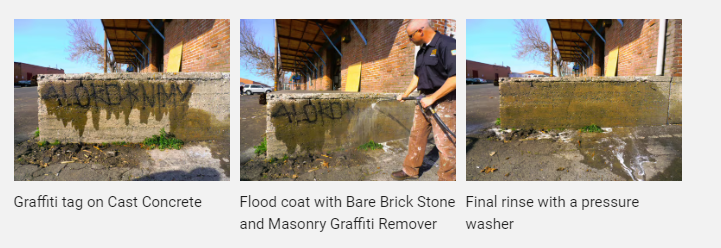How to Remove Paint, Graffiti and Overspray Using World's Best Removal Products
A guide to paint and graffiti removal from concrete and asphalt.

How to remove paint, including graffiti and overspray, curb markings, glyphs, and tags, from concrete and asphalt, is one of the most commonly asked graffiti removal questions. We have tried to address all these jobs with the advice provided below by World's Best Graffiti Removal Products. Continue reading to discover which product is best for your project.
Removing Graffiti and Overspray from Concrete, Block Walls and Pavers
To remove graffiti and overspray from concrete or block walls, use our Bare Brick, Stone & Masonry Graffiti Remover (BBSM).
For typical graffiti, apply three flood coats (with roughly 3-minute intervals between coats), then wait a few more minutes before rinsing with a small pressure washer. 
Agitation while applying this product can greatly assist in the removal process. Continued experience with the product will enable users to judge how much dwell time and number of applications are required for different surfaces and particular spray paints. Patience is key, especially with older or thicker graffiti. It's important to keep the graffiti wet with the product for as long as possible before rinsing.

For certain inks/dyes and specific spray paints (especially reds), Feltpen Fadeout may be necessary to achieve quick and flawless results.
Please refer to the Technical Data Sheets (TDS) for more detailed instructions or feel free to contact us for expert advice before starting your job.
To address any remaining shadows left from spray paints after using removers or solvents, please follow the provided link for further instructions.
Removing Paint, Paint Spills and Line Stripes from Concrete
As a general rule in paint removal, we recommend using a thicker remover for thick paints and a thinner remover for thin paints, including spray paint, that penetrate porous substrates and dissolve them from the font as well as behind.
To remove spray paints, latex, acrylic, and overspray, you can use Bare Brick Stone & Masonry Graffiti Remover. Extra coats and/or extended dwell times may be needed to achieve perfect results on thicker or older paints.
Removing Graffiti, Road Markings or Glyphs from Asphalt
When removing typical spray paint graffiti from asphalt or road markings and glyphs, Bare Brick, Stone & Masonry Graffiti Remover can be applied by brooming it onto the road surface (i.e., applying 3 coats at roughly 3-minute intervals), then rinsed away with a pressure washer. This method usually achieves the desired results quickly and easily.

All asphalt, or tarmac, is black and composed of bituminous oils and aggregate. When the aggregate stones are mixed with hot asphalt cement, the resulting mass becomes black. Over time, as the asphalt oxidizes, the coating on the aggregate breaks down, revealing the color of the aggregate beneath. This can result in a grayish appearance if the asphalt plant used a light-colored aggregate. On most road surfaces like this it is fine to use Bare Brick, Stone & Masonry Graffiti Remover without any visible signs of damage or degradation.
However, some caution should be taken, particularly on newer blacktop roads where extended dwell times with the product can lead to the breakdown of bituminous oils in asphalt, similar to a diesel spill. This can result in runoff water turning black and dirty, necessitating responsible collection and disposal.
For this reason, we recommend using Transgel Paint and Graffiti Remover. Transgel is pH neutral and can be left on for longer periods without degrading asphalt or releasing bituminous oils when pressure washing.
For larger jobs on asphalt, a quick alternative to removing paint or graffiti is to paint over the road using black road paint, available from commercial paint stores, as illustrated in the photos below.

Leave a comment